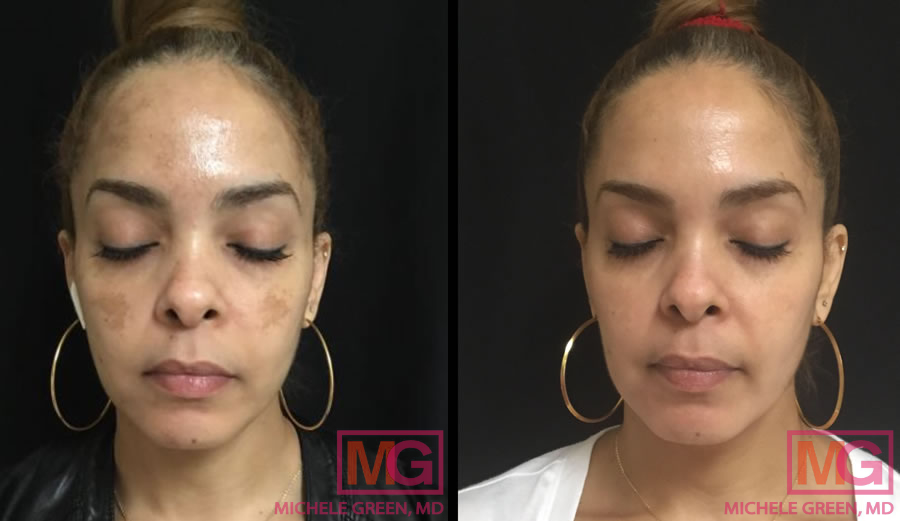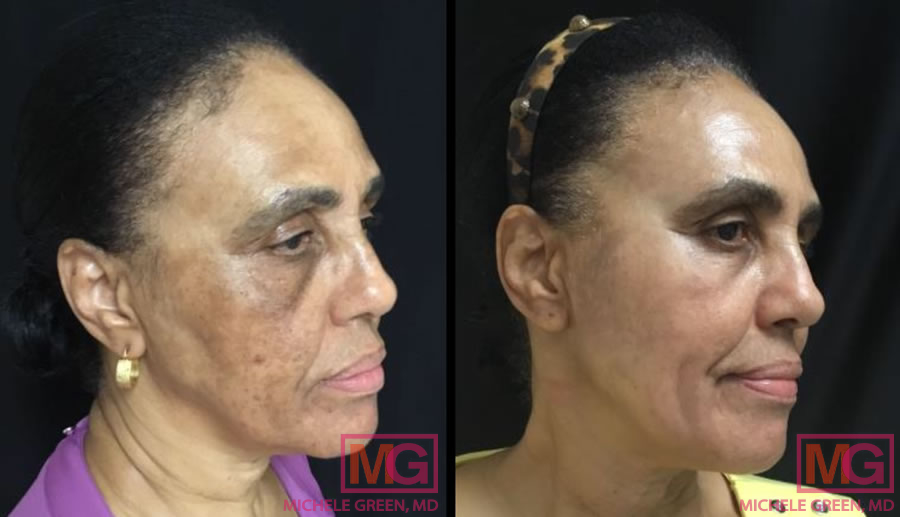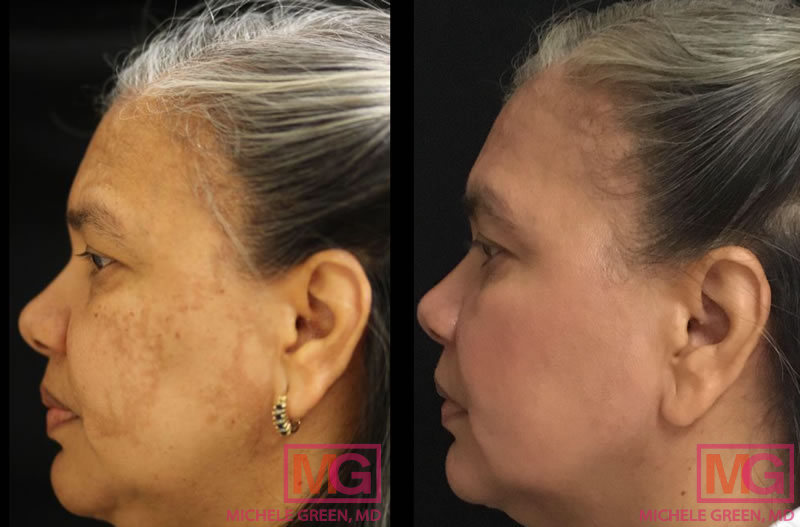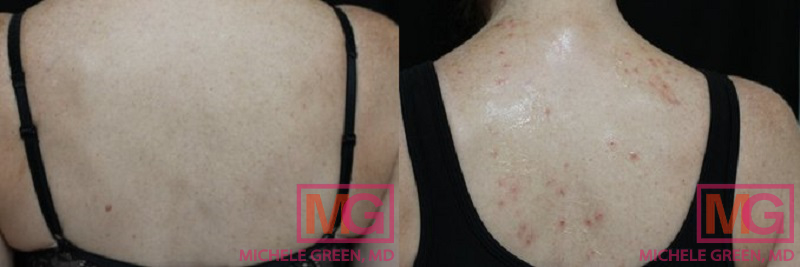How To Remove Age Spots Naturally
As we age, changes begin to occur on the surface of the skin. Fine lines and wrinkles can develop and skin can start to sag, but perhaps one of the most noticeable signs of the natural aging process is the formation of age spots. Age spots are flat brown, black, or gray spots that appear on areas of the skin that have been frequently exposed to the sun. Also known as liver spots, solar lentigines, senile lentigo, or sun spots, these age spots can appear commonly on the face, arms, shoulders, upper back, and hands. While age spots themselves are not harmful or indicative of any underlying health condition, their appearance can be distressing. The spots can range in size but due to their dark color and their appearance on sun exposed areas of your body, like your face and chest, they can be very noticeable. Luckily, advances in dermatology mean that you can easily remove these unwanted age spots on your skin.
There are many treatments found at Dr. Michele Green’s private dermatology office that can safely and effectively remove these unwanted age spots. The most effective procedures include chemical peels and laser treatments, which work to resurface the skin and stimulate cell turnover and the production of new collagen. The result is spot-free, youthful-looking skin in as little as one treatment session. Dr. Michele Green will combine these treatments with a specialized skincare plan that can reduce the appearance of age spots with unique products such as her Vitamin-C Serum and hydroquinones. She will help you design not just an effective treatment plan for your sunspots but the best way to prevent the development of further dark spots with the use of broad spectrum sunscreen.
When considering newly developed dark spots on the skin, it is vitally important to have the spots examined by a board-certified dermatologist, such as Dr. Michele Green. Dr. Green is an expert in treating age spots and sunspots with the most cutting edge laser treatments and chemical peels. For over 25 years, Dr. Green has been consistently voted as one of the best dermatologists in NYC by Castle Connolly, New York Magazine and SuperDoctors. Dr. Green treats age spots and pigmentation in patients of all skin tones. As a leader in non-invasive cosmetic dermatology, Dr. Green will help provide you with the best treatment options for your skin.
What are age spots?
As you age, you may notice the development of flat black, brown, or gray spots on the surface of the skin. These blemishes are called “age spots” and most frequently develop on parts of the skin that have been exposed to the sun over time, including the face, back of hands, shoulders, upper back, and forearms. Age spots appear dark in color as they are the result of the skin’s natural pigment, melanin, clumping together. While age spots are harmless, they can be a nuisance cosmetically and can be removed by a dermatologist.
What causes age spots?
Age spots typically appear in areas that have most frequently been exposed to the sun. When skin is overexposed to the sun, the body produces more of the naturally occurring pigment, melanin, in order to protect the skin from harmful ultraviolet light, also known as UV rays. Melanin is a pigment produced in the body by melanocytes, which are cells that are found in the epidermal layer of skin. The amount of melanin that can be found in the skin is directly proportional to skin color. People with darker skin naturally have more melanin in their skin than people with lighter skin. Melanin functions to keep UV rays from damaging the body’s DNA and can also protect against skin cancer. As such, when skin is overexposed to harmful UV rays, either in the form of sun exposure or tanning beds, the melanocytes overproduce melanin, which leads to hyperpigmentation in the skin. This hyperpigmentation, or coalescing of melanin, is what causes the age spots to appear.
What are the risk factors for developing age spots?
The development of age spots is very common but there are factors that can increase the likelihood of developing the dark spots over time, some of which are lifestyle factors and other of which are biological. One such lifestyle factor that can contribute to the development of age spots is frequent exposure to the sun. The sun’s UV rays can be damaging to the skin, which triggers the increased production of melanin, leading to brown spots. Patients who visit tanning beds frequently are also exposed to harmful UV rays that can potentially lead to the development of age spots over time as well.
A biological risk factor for the development is being over the age of 40. Age spots take time to develop and for that reason, become more common as a result of the natural aging process. Further, patients with lighter skin are also at a higher risk for developing age spots than patients with darker skin. People with lighter skin have naturally less melanin in their skin and, as such, exposure to UV rays triggers increased melanocyte activity. Further, age spots are more visible on patients with lighter skin.
Dermatologist treatment of age spots
While age spots are, themselves, not harmful or indicative of underlying health issues, it is important to get age spots examined and treated by an expert, board-certified dermatologist. If you are concerned about a new spot on your skin, it can be vital for your health to have it look at by a healthcare professional, such as Dr. Michele Green. Some dark spots on the skin can be indicative of skin cancer and Dr. Green will examine the spot to determine if it is cancerous. If the hyperpigmentation is diagnosed as an age spot, experienced dermatologist, Dr. Green, can remove the blemish with the latest, safest treatment methods. At a dermatology office, there are many treatment options, including laser treatment and medical-grade chemical peels that are both safe and extremely effective in removing age spots. When looking to treat age spots, it is important to research a qualified dermatologist, such as Dr. Green.

Cosmelan for dark spots – 10 weeks
How to tell an age spot from a skin cancer?
The development of dark spots on the surface of the skin can either be merely a cosmetic annoyance or, potentially, an indication of skin cancer. According to the Skin Cancer Foundation, 1 in 5 Americans will develop skin cancer by or before the age of 70. It is vitally important to get any new, concerning dark spot checked out by a dermatologist to ensure that the spot is not cancerous. Frequently, dermatologists will be able to determine if the spot is potentially harmful just by looking at it. However, some spots require the performance of a biopsy, a procedure in which a dermatologist will remove a small amount of the affected skin in order to perform further tests.
Different kinds of spots have different causes and characteristics so you can tell the difference between hyperpigmentation, such as age spots, melasma, seborrheic keratoses, and skin cancer. Age spots, one variety of hyperpigmentation, are caused by an overproduction of melanin in the skin, which causes discoloration on the surface of the skin. It is characterized by flat, brown, black, or gray spots and is usually found on areas of the skin that is frequently exposed to the sun. Skin cancer, on the other hand, is caused by uncontrolled reproduction and growth of abnormal skin cells. Risk factors for the development of skin cancer is similar to that of sunspots: exposure to harmful UV rays can lead to development of skin cancer. Skin cancer can be characterized by new, growing, or changing dark spots on the surface of the skin that often have irregular borders. If you have a new or changing dark spot, Dr. Green recommends visiting her dermatology office to check for skin cancer.
Can you get rid of age spots?
When patients wonder, can age spots be removed, the answer is yes! Age spots are not detrimental to your health but may be frustrating cosmetically. For that reason, age spots can be safely and effectively removed at a dermatologist’s office. Dr. Green offers many treatment options at her New York City office that are safe for all skin types. When you make your initial consultation appointment with Dr. Green, she will walk you through all of your options and together, you will determine the treatment or series of treatments that works best for you.
Which procedures remove age spots?
There are many treatment options that are available when looking to remove age spots. When you have a consultation with Dr. Green in her NYC dermatology office, she will examine the treatment area and make a recommendation about the best treatments for your specific needs. Depending on the degree of pigmentation, the number of age spots, and your skin type, there are many different processes which can be utilized. Patients with darker skin tones, in general, have more sensitive skin and require special lasers or chemical peels to remove the pigmentation.
The first step in the treatment process will be eliminating the dark spots on the top layer of the skin. To do so, Dr. Green may recommend the use of a chemical peel, such as a Cosmelan peel, or the use of a laser, such as the Fraxel laser, Picosure laser, or Alex-Trivantage laser. Chemical peels and laser treatments are the two spot-removal treatments that Dr. Green most frequently employs. They are extremely effective at eliminating age spots and are quick to administer and safe. There are other options available at Dr. Green’s office, however, including microdermabrasion, IPL, and HydraFacials.
Topical creams and serums are also effective both in the treatment of dark spots and in the prevention of further development of age spots. Some patients prefer the use of skin lightening creams, which serve to brighten the skin. Dr. Green recommends the use of antioxidants, such as Vitamin C, to revitalize the new skin after treatment. It is also extremely important to protect the skin following age spot-elimination treatment. To avoid further sun damage, sun protection in the form of sunscreen with SPF of at least 30 is imperative.

Cosmelan before and after
Chemical peels for removing age spots
When looking to eliminate age spots, one of the most effective treatments is the use of chemical peels. Chemical peels work to rejuvenate the treatment area by exfoliating the top layer of skin to promote cell turnover for smoother, clearer skin. Made up of a combination of chemicals, such as glycolic acid, kojic acid, or trichloroacetic acid, chemical peels are very effective at eliminating hyperpigmentation, such as age spots, from the surface of the skin.
Chemical peels work through the use of acids, which react with the skin to gently break down the dead skin cells found on the surface. This leads to an exfoliation and peeling of the dead skin cells. The process causes micro-injuries to the skin, which triggers the body’s naturally healing process and stimulates the production of new skin cells. This procedure corrects discoloration on the surface of the skin, thereby eliminating age spots.
The procedure is simple but highly effective. When you have your consultation appointment with Dr. Green, she will make a determination about the type and strength of chemical solution that will be most effective for you. Different chemical peels will be necessary depending on the severity of the hyperpigmentation and the skin type of the patient. Dr. Green will apply the chemical peel at her office with directions for how long the chemical solution should remain on the treatment area. For most patients, they can remove the peel at home with a prescribed lotion or moisturizer.
Lasers for treating Age Spots
When it comes to fully eliminating the appearance of age spots, lasers are the gold standard treatment. Laser light therapy is extremely safe and effective for removing age spots and the procedure itself is simple and quick. Dr. Green offers a variety of different types of lasers at her office depending on the scope of the treatment area and the skin type of the patient. Most frequently, Dr. Green will treat age spots with either the Fraxel Dual Laser, Alex-Trivantage Laser, or the Intense Pulsed Light (or IPL) laser.
Fraxel Laser – The Fraxel Laser works by resurfacing the treatment area and is FDA approved to treat age spots, sun damage, and a variety of other blemishes on the skin, such as acne scars, fine lines, and wrinkles. The treatment works by creating micro-injuries on the surface of the skin, which stimulates the body’s natural healing response and the production of new collagen. This, in turns, leads to skin cell turnover, thereby eliminating the hyperpigmentation on the skin. The Fraxel laser is unique in that it has two different wavelengths, which can be used to treat target different conditions. The 1927 wavelength is best to treat hyperpigmentation, such as age spots, while the 1550 wavelength is best for eliminating fine lines, wrinkles, and acne scars. The two wavelengths can be used within one treatment session to eliminate the appearance of acne scars and provide patients with a youthful, rejuvenated look.
Alex Trivantage – The Candela Alex TriVantage laser is an ndYag laser that is best used to address discreet sunspots or age spots on the skin. When applied to the treatment area, the Alex-Trivantage laser emits a wavelength of light, which is absorbed into the melanin-rich area and causes the pigmentation to be eliminated while leaving the surrounding skin unaffected. The procedure itself is quick and painless and requires no downtime following the treatment. Most patients only require 1-2 treatments for optimal results and the effects of the treatment can be seen in one to two weeks.
Cryotherapy for getting rid of age spots
Cryotherapy used to be a very common process for the elimination of age spots but is not frequently used anymore. The procedure involved the use of liquid nitrogen to freeze off age spots and other skin lesions. Cryotherapy is no longer the preferred treatment method because it is not as effective as other procedures, such as chemical peels, and liquid nitrogen can cause blistering and scabbing as common side effects and discomfort on the surface of the skin. Rather than Cryotherapy, Dr. Green recommends the use of chemical peels for better results.

Cosmelan for dark spots – 1 year
Microdermabrasion
While micro-dermabrasions were at one time very common as a treatment for age spots, they are, similarly to cryotherapy, no longer as effective as other treatments, such as chemical peels and lasers. Microdermabrasion, similarly to chemical peels, works by exfoliating the skin to remove dead skin cells and stimulate cell turnover for clear, bright skin. Microdermabrasion, however, is performed with a handheld device that sprays aluminum oxide or sodium bicarbonate crystals to exfoliate the skin. A vacuum device is then applied to the skin to remove the dead skin cells. The procedure can take about an hour and will generally require several treatment sessions for the best results. For that reason, there are newer and more effective technologies, such as chemical peels and lasers, that will provide more dramatic results in less time.
Vitamin C serum to remove age spots
In addition to chemical peels and lasers, there are topical skincare products that are effective in reducing the appearance of age spots. Skincare products such as topical creams and serums can be used in addition to other treatments or on their own. Dr. Green has developed her own line of products with the MGSKINLABS, which are curated to be the most effective anti-aging products available. One such product that is very effective at reducing the appearance of age spots is MGSKINLABS’ own Vitamin C formulation, Vita-C Serum. A powerful antioxidant, the product works by reducing pigmentation without any irritation to the skin. The Vita-C-Serum reduces the appearance of age spots by stimulating the production of collagen and promoting cell turnover for clearer, brighter skin.
What is the best way to get rid of age spots?
With many potential treatment for eliminating the appearance of age spots, it can feel difficult to navigate the options. Dr. Green recommends and employs the use of chemical peels and lasers as her primary methods of treating age spots because they are very safe and effective. When creating a treatment plan for her patients, Dr. Green takes into account the scope of the treatment area and the patients skin tone in order to develop the plan that is safe and provides the most optimal results.
The American Academy of Dermatology recommends for patients who are interested in using topical creams to eliminate age spots to consult with a dermatologist first. There are a plethora of over-the-counter fade creams containing chemicals that range from hydroquinone to niacinamide to kojic acid to retinol and it can be challenging to know which cream is actually safe and effective. Some beauty websites may recommend the pairing of a retinoid and a mild steroid but before you make the purchase, be sure to consult with Dr. Green about which products will work well for you.
How to get rid of age spots on the face
The face is one of the most common locations for age spots to develop on the body. Age spots are largely caused by overexposure to the sun and the face is an area that is most frequently exposed to the sun as few people where protective clothing on their face while outside. For patients who have developed sunspots on the face, chemical peels or laser treatments are extremely effective in eliminating age spots in that area. When you have your consultation with Dr. Green, she will assess the treatment area and determine which treatment is best for you.
How to get rid of age spots on the hands
Similarly to the face, the hands are another common area of the body for age spots to develop. Especially in the summer, the hands are rarely covered and are therefore often hit with direct sunlight. When it comes to eliminating age spots on the hands, laser treatments, particularly the Fraxel laser and Alex-Trivantage laser, are likely the best treatment method.

Sunspot removal on back with AlexTrivantage
How to get rid of age spots on legs
For sunspots that develop on the legs, Dr. Green will assess the treatment area before making a recommendation on the best treatment process. For most patients, laser treatments are the most effective option for removing age spots on the legs.
How to get rid of age spots with hydrogen peroxide
Another method of age spot treatment that can be performed in a dermatologist’s office is using hydrogen peroxide. For this procedure, the dermatologist will apply the hydrogen peroxide solution to the age spot. The solution works to dissolve the pigment in the spot but may require several treatments for optimal results, particularly if the spot is large or very dark. There are potential side effects of scabbing and irritation to the surface of the skin. For that reason, Dr. Green does not frequently use hydrogen peroxide treatment in her office.
How to get rid of age spots naturally
Age spots develop on the body over time as a result of sun exposure but they will not typically go away on their own. For that reason, if you are looking to eliminate age spots, you will need to seek a dermatologist for treatment. If you are not interested in laser treatment or chemical peels, Dr. Green may prescribe MGSKINLABS Vita-C-Serum, which is a vitamin C serum that helps to eliminate age spots by stimulating cell turnover and the production of collagen.
How to get rid of age spots on the face fast
For those looking to eliminate age spots on the face quickly, there are several treatment methods available and Dr. Green’s office that will do so. Laser treatment and chemical peels can both achieve outstanding results in as few as one treatment session. Most laser treatments take only 15-30 minutes to complete and you will see results in one to two weeks following treatment.
How to prevent the development of age spots
A major risk factor for developing age spots is being exposed to harmful UV rays either in the form of direct sunlight or in tanning beds. For that reason, in order to promote skin wellness and avoid the development of age spots, patients should practice strict sun avoidance. To do so, you should employ the use of sunscreen of at least SPF 30, wear protective clothing, or avoid going in the sun when it is at its most intense – between the hours of 10am and 2pm. Further, you should avoid the use of tanning beds.
How to get started removing age spots today?
There are many age spot removal treatments available at Dr. Michele Green’s Upper East Side dermatology office, including cutting edge laser treatments, such as the Fraxel laser, and Alex-Trivantage lasers. Dr. Green is a specialist in removing pigmentation, sun damage, and age spots in patients of all skin tones. Chemical peels with trichloroacetic acid, Cosmelan peels, and Mesopeels, are some of best treatments available to remove unwanted pigmentation, especially in patients with darker skin tones. Dr. Green personally performs all laser treatments in her private NYC dermatology office for the highest caliber quality of care. With one to two treatment sessions, Dr. Green can eliminate all signs of age spots wherever they have appeared. To find out which treatment would be best for you call us at 212 535 3088 or contact us online today.
 212-535-3088
212-535-3088